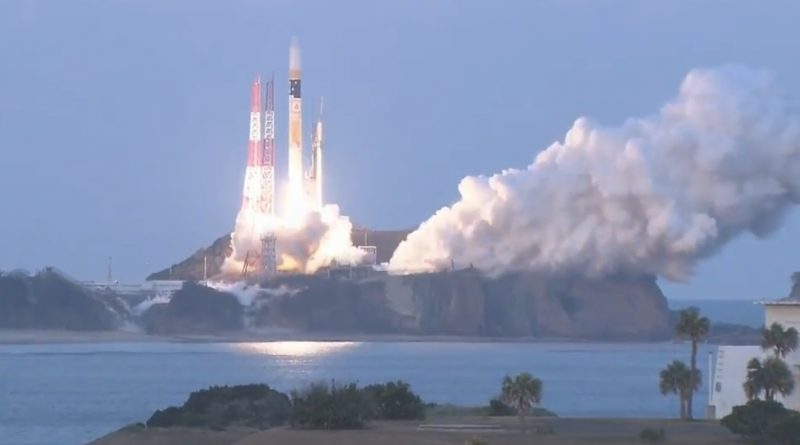Astro-H Space Observatory launches atop H-IIA to deliver unprecedented Views of the X-Ray Universe
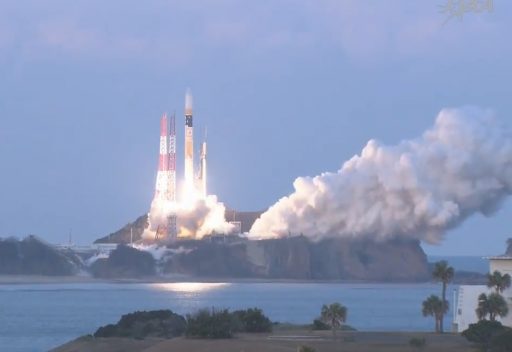
Japan’s new flagship space observatory was lifted into orbit on Wednesday by an H-IIA rocket, embarking on a mission to observe the most extreme environments in the universe. Outfitted with two pairs of X-ray telescopes and a gamma-ray detector, Astro-H covers a broad energy range and sets out to deliver the highest resolution ever achieved in X-ray spectral analysis in the high-energy regime.
The H-IIA rocket with Astro-H and three smaller secondary payloads blasted off from its sea-side launch pad on Tanegashima Island at 8:45 UTC, thundering uphill under the power of its two Solid Rocket Boosters and large Core Stage. The boosters departed the vehicle after two minutes and the core stage headed out of the atmosphere as part of a 6.5-minute burn, flying a lofted trajectory to enable the second stage to reach the desired circular orbit with only one engine burn. The second stage successfully delivered the stack to orbit and Astro-H was sent on its way 14 minutes after liftoff. The three small satellites were to follow suit over a 20-minute period.
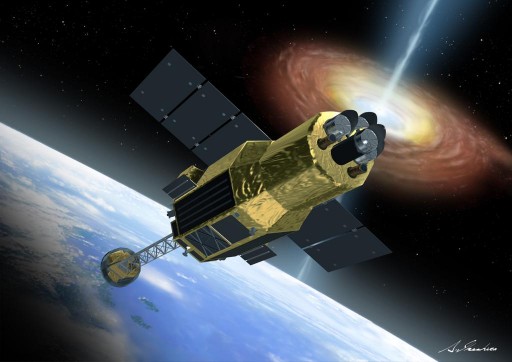
The Astro-H project is led by the Japan Aerospace Exploration Agency with contributions from NASA, Europe and Canada as well as international universities. It is the sixth in a series of Japanese X-ray observatories that debuted back in 1979. Astro-H carries pairs of telescopes – two sensitive in the soft X-ray range the others capable of detecting hard X-rays. One telescope is coupled to an imaging detector while the second telescope of each pair feeds a spectrometer to be able to collect X-ray imagery and spectra of the same sources at the same time.
Observations in the X-Ray spectrum can only be made from space because Earth’s atmosphere blocks X-ray light before reaching the ground.
Astro-H will peer into the most extreme regions of the universe and is hoped to deliver the highest resolution spectra in X-rays to open up a new window on the vast field of high-energy astrophysics. Scientists hope to use Astro-H to uncover the mechanisms driving the evolution of galaxy clusters over billions of years.
>>Astro-H Spacecraft & Instruments
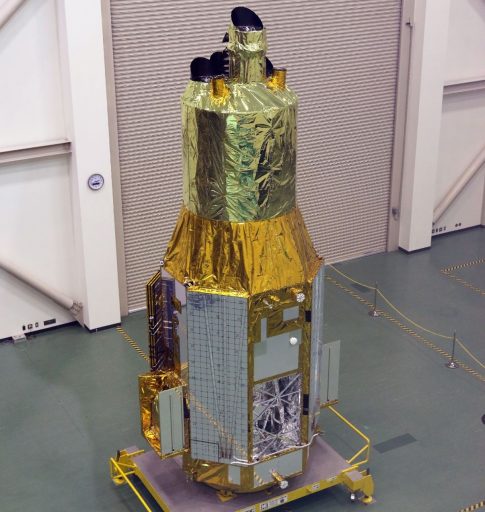
The Astro-H mission is expected to deliver breakthrough results in a diverse area of science, ranging from the large-scale structure of the universe and its evolution to the behavior of matter in strong gravitational fields, the physical conditions at sites of cosmic-ray acceleration, and the study of dark matter in galaxy clusters.
The X-ray range of the electromagnetic spectrum is suitable for probing extreme environments in the universe like areas near black holes or neutron stars, high-temperature gas and zones of electron acceleration.
Astro-H is hoped to be the first mission to successfully use microcalorimeters as detectors, offering a much higher resolution than conventional CCD detectors. Microcalorimeters were previously flown on sub-orbital tests, but have not yet seen operational use in orbit after an earlier mission failure.
Topped with the Astro-H observatory and its three smaller companions, the 53-meter tall H-IIA rocket was moved Tuesday night from its assembly building to the Launch Pad on the southernmost tip of Tanegashima Island where bad weather had pushed the mission from a planned Friday launch date as winds and freezing layers had to move out to permit a launch.
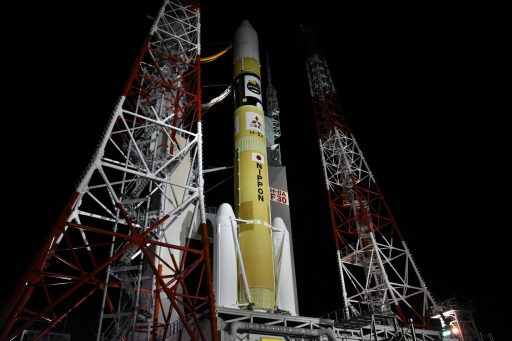
Once at the pad, H-IIA was hooked up to ground systems and engineers closed out the base of the rocket and the various pad facilities before departing the Launch Complex when the 400-meter safety zone came into effect for vehicle power up. Once activated, the H-IIA rocket underwent an extensive set of checkouts to award the launcher a clean bill of health and proceed with propellant loading.
With the safety zone widened to three Kilometers at around X-7 hours and 30 minutes, the first steps of the three-hour long propellant loading sequence were initiated. Entering cryogenic tanking, the first stage was loaded with 87,100 Kilograms of -183°C Liquid Oxygen and 15,700kg of -252°C Liquid Hydrogen while the second stage received 14,100kg of LOX and 3,100kg of LH2.
>>H-IIA Launch Vehicle Overview
Tanking entered replenish at X-4 Hours as cryogenics were kept topped up at flight level and H-IIA went through a second round of testing involving communication checks in S- and C-Band, checks of the Flight Termination System, slews on the first and second stage engines and verifications of the Flight Control System. Inside X-1 hour, H-IIA was put through a final set of reconfigurations including the load of updated flight parameters into the computers of the launcher accounting for the latest measurements of upper level winds.
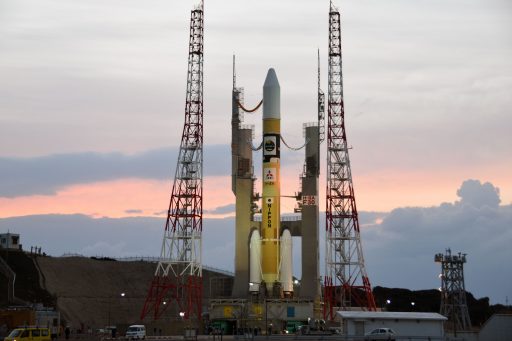
Getting ready for liftoff, Astro-H was switched to internal power and all Stations reported a GO to head into the Automated Countdown Sequence at X-4 minutes and 30 seconds to set up for liftoff. Throughout the final minutes of the countdown, computers choreographed an impressive list of tasks while also monitoring all vehicle parameters, ready to trigger an abort in case of problems.
Tanks on the two-stage stack were topped up at flight level and closed their Fill & Drain Valves as well as vent valves to begin pressurization for flight using Helium gas. H-IIA was transitioned to battery power and the launch pad’s sound suppression system started pouring water onto the pad with one minute to liftoff. H-IIA activated thermal batteries on the boosters, armed onboard ordnances and the launcher assumed control of the countdown as ground computers handed off to the launch vehicle.
The LE-7A main engine was commanded to ignite at T-5.2 seconds when the main fuel valve was opened and turbopump turbines began spinning up before the oxidizer valves were opened and the ignition was triggered within the gas generator and combustion chamber. Throttling up to a total thrust of 86,000 Kilogram-force, the engine was monitored by computers before committing the rocket to flight by lighting the boosters.
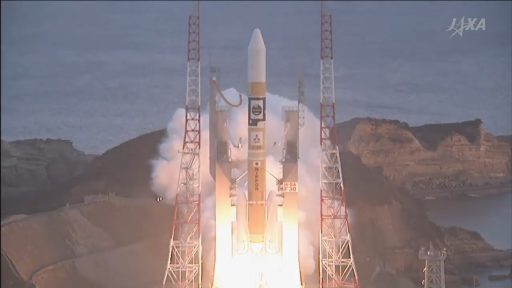
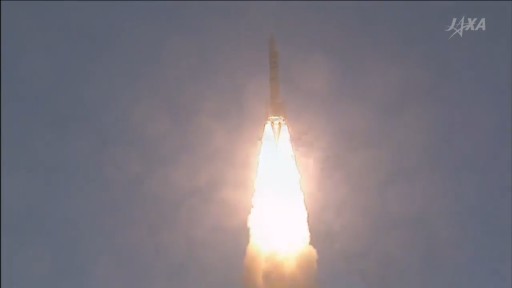
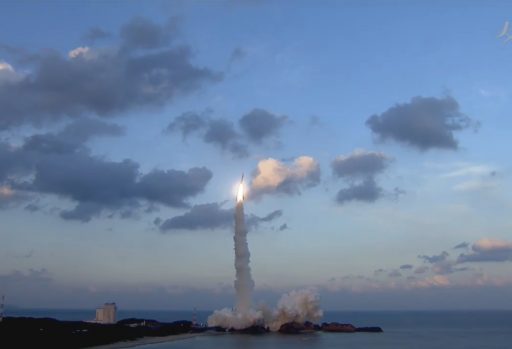
Upon ignition of the twin SRB-A boosters, H-IIA jumped off its launch pad with a total thrust of 560 metric-ton-force. Liftoff occurred at 8:45 UTC on H-IIA quickly climbed uphill given its high thrust to weight ratio owed to the boosters generating the majority of thrust during the initial flight phase.
The familiar scream of the H-IIA rocket was heard as the launcher pitched and rolled on its south-easterly ascent trajectory, set for a fast trip across the Pacific Ocean. Departing Tanegashima Island, H-IIA burned 1,600 Kilograms of propellants each second of powered flight, passing Mach 1 one minute after liftoff followed by Maximum Dynamic Pressure a few seconds later.
Each of the twin boosters burned through 65 metric tons of propellants during a 100-second burn to deliver 281 metric ton-force of thrust. The SRB-A booster is 15 meters long and 2.5 meters in diameter.
Burnout of the boosters occurred one minute and 38 seconds into the flight when their chamber pressure dropped below a pre-set threshold, triggering the Flight Control System to separate the SRBs after a ten-second delay to ensure residual thrust had tailed off and the boosters would fall safely in the Ocean. Having accelerated the rocket to a speed of 1.5 Kilometers per second, the boosters were separated using pyrotechnics and struts that ensured the two boosters dropped away from the Core Stage in a clean fashion with not inadvertent contact.
H-IIA continued powering towards orbit relying on its LE-7A engine alone, guzzling down 260 Kilograms of supercold cryogenic propellants per second to generate 109 metric-ton force of vacuum thrust. Throughout the burn of the first stage, the vehicle showed a good performance and continued flying down the predicted trajectory.
For this mission, H-IIA was flying a lofted trajectory during first stage flight to quickly gain altitude and only require a single burn of the second stage to achieve a circular orbit 575 Kilometers in altitude – instead of a flight profile involving an elliptical transfer orbit and a lengthy coast of half an orbit. Passing 170 Kilometers in altitude just over 4 minutes after launch, H-IIA split open its payload fairing halves which then separated from the ascending rocket, revealing the Astro-H spacecraft and the secondary payloads.
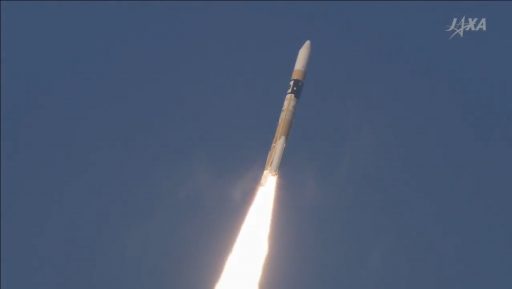
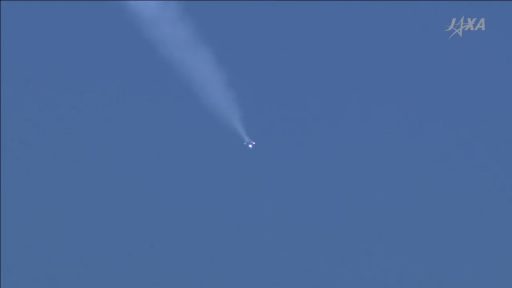
Shutdown on the 37-meter long first stage was commanded six minutes and 38 seconds into the mission after it accelerated the launcher to a speed of 4.8 Kilometers per second. Eight seconds after MECO, the first stage was separated using pyrotechnics and loaded springs to move away from the upper stage. Assuming control of the flight 320 Kilometers in altitude, the 9-meter long second stage ignited its LE-5B engine that soared up to a total thrust of 14,000 Kilogram-force to finish the job of boosting the stack into orbit.
The second stage burn had a planned duration of six minutes and 32 seconds to deliver the stack to a nearly circular orbit around 575 Kilometers in altitude, inclined 31 degrees. No issues came up during the critical firing of the second stage that made a clean shutdown 13 and a half minutes after liftoff, arriving in the expected orbit.
Engine cutoff marked the start of a fast-paced sequence of events, dampening body rates on the second stage to create safe conditions for spacecraft separation. Astro-H was sent on its way 14 minutes after launch, embarking on its multi-year mission studying the depths of the universe.
Following spacecraft separation 580 Kilometers over the Pacific, Astro-H was tasked with stabilizing its orientation, checking in with ground stations and deploying its solar panel. Over a period of days and weeks, the observatory will be readied for operations, deploying its Fixed Orbital Bench to reach the proper focal length required by the X-Ray telescopes, increasing the satellite’s total length to 14 meters.
Next up for separation from the launcher were the three secondary payloads. ChubuSat-2 was expected to separate 22 minutes after liftoff followed by its twin, ChubuSat-3, five minutes later.
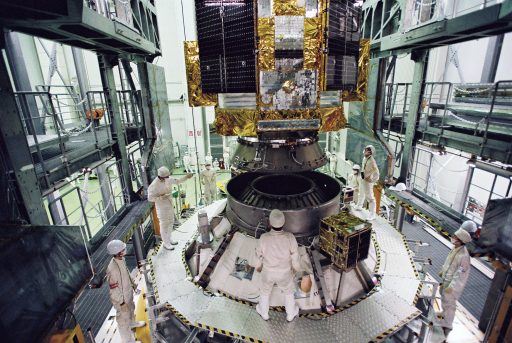
The 50-Kilogram satellites are equipped with visible imagers for Earth observations at a resolution of ten meters, an infrared sensing system to study a detection method for orbital space debris, and a radiation sensor to examine radiation from the sun and the Earth.
Horyu.4 was set for separation 32 minutes into the mission to start a demonstration mission with ten separate payloads and experiments. The satellite will demonstrate high-voltage solar arrays and an arc thruster system along with a plasma management device to prevent the spacecraft from electrically charging. Also, Horyu-4 will compare different solar cell coatings and deploy a materials science experiment studying polymers and their degradation over an extended period of time.
The health of the secondary payloads will be confirmed after each checks in with its respective ground station in the hours after launch.

